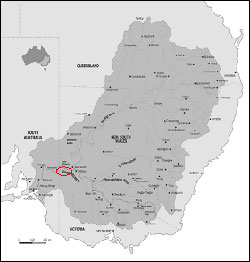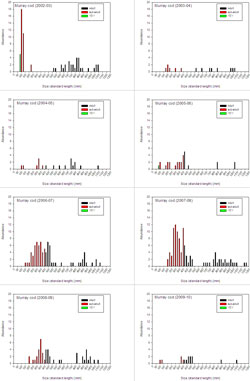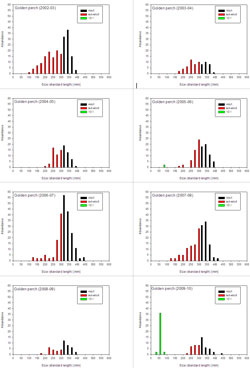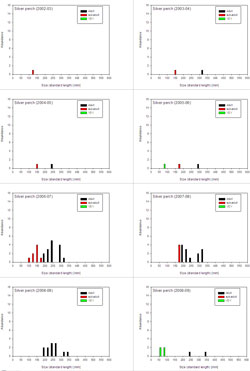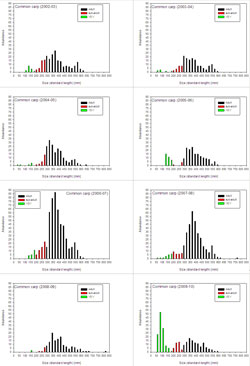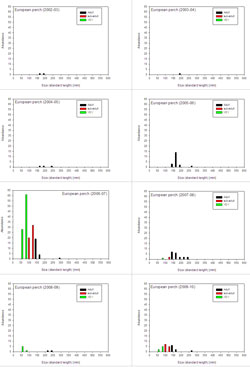A summary of the relative abundance and size-class distribution of large-bodied fish in the Mallee region of the lower Murray River in the period 2002-10

Recreational Fishing Grant Program – Research report
Author - Todd Wallace
A report prepared by the Murray Darling Freshwater Research Centre, funded by the Victorian Government to improve recreational fishing in Victoria through revenue from Recreational Fishing Licences.
AUGUST 2010
This research report was prepared and published by the Murray Darling Freshwater Research Centre following a grant provided by the Department of Primary Industries through the Recreational Fishing Grants Program.
This publication is copyright. No part may be produced by any process except in accordance with the provisions of the Copyright Act 1968.
Preferred way to cite this publication:
Wallace, T. (2010). A summary of the relative abundance and size-class distribution of large-bodied fish in the Mallee region of the lower Murray River in the period 2002-10. Recreational Fishing Grant Program Final Report. Murray Darling Freshwater Research Centre.
For more information about Murray Darling Freshwater Research Centre visit the website at http://www.mdfrc.org.au/.
Executive Summary
Within the Mallee region of the lower Murray-Darling catchment area, 20 species of native freshwater fish are considered to have naturally occurred prior to European settlement. Nine of these are locally extinct, and are either listed, or regarded as threatened species under state or federal legislation. Since European settlement, seven species of non-native fish have also been recorded in the lower Murray-Darling catchment. Omitting the vagrant and potentially locally extinct native species, the current fish fauna of the lower Murray-Darling catchment area typically consists of 11 native and 5 non-native fish species. The purpose of this report is to summarise the trend in abundance and composition of commonly encountered large-bodied fish, particularly those with high socio-economic value to recreational fishers, within the Mallee region of the lower Murray River between Lock and Weir 9 and the South Australia-Victoria Border for the period 2002-10. The study area includes a number of anabranch habitats that form permanent creeks within Victoria.
The data is presented in the context of the relative abundance and size class structure of Murray cod, Golden perch, Silver perch, Common carp and European perch. Freshwater catfish, although anecdotally captured by recreational fishers, have not been recorded during the surveys reported on here. River blackfish, Trout cod, Two-spined blackfish, Murray River Galaxid and Macquarie perch have not been recorded in the region in the past two decades. This assessment of the fish community has shown that the composition of the large bodied species assemblage within the lower Murray River within the section between Lock and Weir 9 and the South Australia-Victoria Border has remained stable during the period 2002-10; i.e. there has been no new large-bodied species detected, and all species that were present in early surveys were detected in subsequent surveys.
The 2002-2010 period during which these surveys were undertaken covers a period of extended low flows, during which large-scale overbank flooding did not occur due to a combination of drought and river regulation. This period of extended low flows is likely to have directly or indirectly affected the abundance of some, if not all species; particularly those that are considered to be dependent of periods of high flows for spawning. It is typically considered that a robust population structure requires all life-history stages to be well represented in order for populations to be self-sustaining. The survival of young fish must at least match the mortality of mature fish if a population is to remain viable. Based on this benchmark and the data presented here, populations of native species Murray cod, Golden perch, Silver perch and the introduced species, European perch would be considered suppressed. For each of the native species, young-of year fish (YOY; less than one year old) were only detected in 2 out of 8 survey years. YOY European perch were detected in 4 out of 8 survey years. The introduced Common carp was the only species for which each life-history stage (YOY, sub-adult and adult) was detected in every sampling year.
The impact of recreational angling upon Murray cod and Golden perch populations needs to be taken into account. Other authors have demonstrated that in populations where angling pressure is low, strong numbers of YOY, sub-adult and adult fish are present. However, there is evidence in the data presented here to indicate a substantial contraction in the relative abundance of Murray cod between 600-800 mm within the study region, and little evidence of YOY recruitment to the population. Consequently, it is likely that angling pressure poses a considerable risk to Murray cod; a threatened species, and that the local population may need an increased level of protection to remain viable. Angler pressure may also be a considerable risk for Golden perch in this region. A rapid appraisal of angler effort within the same study region as that reported on here, demonstrated that 93% of golden perch captured above the legal size limit were kept by anglers. Given (i) there is currently no closed season for this species (ii) the minimum legal size is less than the known size at maturity for females, and (iii) the dependence of this species on periods of high flows/floods to induce spawning, this level of take may not be sustainable for Golden perch, particularly during extended periods of low flow.
Acknowledgements
Sampling of the fish community within this section of the lower Murray River has been undertaken by The Murray-Darling Freshwater Research Centre (MDFRC) on an annual basis since 2002-03 to the current year (2009-10). The data was collected as a key component of successive projects. The research program Lindsay Island Fish and Water Quality (2002-07) was funded by the Australian Government's Department of Agriculture, Fisheries and Forestry (2002-03); and the Mallee Catchment Management Authority (2003-07). The annual surveys undertaken as part of The Living Murray (TLM) condition monitoring program (2004-10) at Victorian components of the Chowilla Floodplain including Lindsay-Mulcra-Wallpolla Islands Icon Site (http://www.mdba.gov.au/) were funded by the Murray-Darling Basin Authority (formally the Murray-Darling Basin Commission). The production of this report was funded by the Victorian Government using Recreational Fishing Licence fees.
The funding agencies listed above, and the logistical support MDFRC has received from the respective staff of these agencies is gratefully acknowledged. The author would also like to specifically thank the many MDFRC staff members who have been involved in the development of the monitoring programs, and the collection and subsequent management of the field data that has generated a very valuable data set.
Introduction
Project Scope and Objectives
The purpose of this report is to summarise the trend in abundance and composition of commonly encountered large-bodied fish, particularly those with high socio-economic value to recreational fishers, within the Mallee region of the lower Murray River between Lock and Weir 9 and the South Australia-Victoria Border. This includes a number of anabranch habitats that form permanently flowing creeks within Victoria. The data is presented in the context of the relative abundance and size class structure of Murray cod (Maccullochella peelii peelii), Golden perch (Macquaria ambigua), Silver perch (Bidyanus bidyanus), Common carp (Cyprinus carpio) and Redfin (Perca fluviatilis).
Sampling of the fish community within this section of the lower Murray River has been undertaken by The Murray-Darling Freshwater Research Centre (MDFRC) on an annual basis since 2002-03 to the current year (2009-10). The data was collected as a key component of the research program Lindsay Island Fish and Water Quality (2002-07) and annual surveys undertaken as part of The Living Murray (TLM) condition monitoring program (2004-10) at Victorian components of the Chowilla Floodplain including Lindsay-Mulcra-Wallpolla Islands Icon Site (http://www.mdba.gov.au/).
Native Fish Communities within the lower Murray-Darling Rivers
Drainage and catchment divisions, together with latitude, dictate the fish fauna found within rivers. Anthropogenic impacts, most notably the establishment of barriers to fish movement, over-fishing, habitat fragmentation, and flow regulation have drastically influenced the distribution of native fish within the lower Murray- Darling catchment. Twenty-two native fish taxa (21 species and one species complex of up to four carp-gudgeon Hypseleotris spp.) are considered to have existed in the lower Murray- Darling catchment at the time of European settlement. However, the congolli (Pseudaphritis urvillii ) is catadromous and would rarely have migrated upstream from the Murray estuary into the lower Murray- Darling catchment (Gilligan 2005), and the study region lies outside the southern range limit of Hyrtl's tandan (Neosilurus hyrtlii) (Lintermans 2007). Of the 20 remaining species expected to regularly exist within the catchment, three species; Trout cod (Maccullochella macquariensis), Macquarie perch (Macquaria australasica), and Dwarf flat-headed gudgeon (Philypnodon macrostomus) are only known from the Murray River and have not been recorded in the Darling River. Spangled perch (Leiopotherapon unicolour) is only regularly captured in the Darling River above Menindee, and would be considered a vagrant in the lower Murray. Therefore, 19 species are expected in the lower Murray and 17 species are expected in the lower-Darling components of the lower Murray-Darling catchment (Table 1) (Gilligan 2005).
Within the Mallee region of the lower Murray-Darling catchment a total of nine of the 20 (45%) native freshwater fish species are either listed, or regarded as threatened species; eight species are listed as threatened under state or federal legislation. Flat-headed galaxias, although not listed as threatened under any jurisdiction, are considered likely to be locally extinct in the lower Murray-Darling catchment (Table 1). The entire ecological community of the lower Murray- Darling catchment has been declared endangered as part of the lower Murray and lower Darling endangered Ecological Communities under the NSW Fisheries Management Act 1994. These ecological communities include all main channels, tributaries, anabranches, lagoons, wetlands and lakes of the entire catchment. Since European settlement, an additional seven species of non-native fish have been recorded in the lower Murray-Darling catchment (Table 2).
There have been no reports of the native Southern pygmy perch, Flat-headed galaxias, Olive perchlet, Southern purple spotted gudgeon, Trout cod, or Macquarie perch in the lower Murray-Darling catchment for several decades. After a prolonged period without being recorded in the region, Short-headed lamprey, have recently been recorded at the fishway installed at Lock and Weir 7. Murray hardyhead have only been recorded in isolated saline wetlands in Victoria in recent years, and not in the Murray or Darling River channels. A number of the exotic species have not been recently recorded in the last decade, including Brown trout and Tench. Omitting the vagrant and potentially locally extinct species, the current fish fauna of the lower Murray-Darling catchment typically consists of 11 native and 5 non-native fish species.
Table 1 - Native Fish species previously recorded in the lower Murray-Darling catchment
| Common name | Scientific name |
|---|---|
Australian smelt | Retropinna semoni |
Bony herring | Nematalosa erebi |
Carp gudgeon | Hypseleotris spp. |
Dwarf flat-headed gudgeon | Philypnodon macrostomus |
Freshwater catfish | Tandanus tandanus |
Flat-headed gudgeon | Philypnodon grandiceps |
Fly-specked hardyhead | Craterocephalus stercusmuscarum fulvus |
Golden perch | Macquaria ambigua |
Flat-headed galaxias | Galaxias rostratus |
Murray-cod | Maccullochella peelii peelii |
Murray hardyhead | Craterocephalus fluviatilis |
Olive perchlet | Ambassis agassizii |
Short-headed lamprey | Mordacia mordax |
Silver perch | Bidyanus bidyanus |
Southern purple-spotted gudgeon | Mogurnda adspersa |
Southern pygmy perch | Nannoperca australis |
Murray-Darling rainbow fish | Melanotaenia fluviatilis |
Table 2 - Exotic fish species previously recorded in the lower-Murray-Darling Catchment
| Common name | Scientific name |
|---|---|
Brown trout | Salmo trutta |
Common carp | Cyprinus carpio |
Gambusia(Mosquito fish) | Gambusia holbrooki |
Goldfish | Carassius auratus |
Redfin | Perca fluviatilis |
Oriental weatherloach | Misgurnus anguillicaudatus |
Tench | Tinca tinca |
Methods
Sampling
Sampling of the fish community within the lower Murray River in the section between Lock and Weir 9 and the South Australia-Victoria Border (see Figure 1) has been undertaken on an annual basis since 2002-03 to the current year (2009-10). Surveys were undertaken in spring between 2002-03 and 2008-09. The survey timing was shifted to autumn in 2009-10 to align with the timing of surveys undertaken at other Icon Sites in the Murray-Darling Basin Authority's The Living Murray (http://www.mdba.gov.au/) program.
A nested sampling design consisting of sites within reaches within macrohabitats was used to assess the condition of fish assemblages. At the highest level of sampling, macrohabitats were defined as (i) Riverine (i.e. the Murray River), (ii) No/Slow Flow Anabranches, and (iii) Fast Flowing Anabranches. Four Riverine (e.g. within the weir pools of Lock and Weir 6, 7, 8 and 9) reaches were established, with reaches established in five No/Slow Flow Anabranch and two Fast Flowing Anabranch creeks within Victoria. Three sampling sites were established in all reaches except one of the fast flowing anabranches, in which only two sites were used due to its short length.
Click the image to view a larger version
Figure 1: Location of study sites on the Murray River between Wentworth and the South Australia-Victoria border. Map from Murray-Darling Basin Commission.
Sampling involved 12 × 90 second boat-mounted electrofishing shots (Pulsed DC 4800–5000 Watt, 60–120 Hz) at each of site, covering approximately 300–400m of channel length. This was consistent with Sustainable Rivers Audit (SRA) fish assessment methods (Davies et al. 2008) and with the TLM consistent monitoring framework for fish (MDBA 2009). Each fish collected was measured for standard length (SL) to the nearest 1 mm whenever possible/feasible. Fish identifications followed McDowall (1996) and Lintermans (2007).
Data Analysis
Data for all sites was pooled to provide a regional (lower Murray River and associated anabranch creeks within the section between Lock and Weir 9 and Lock and Weir 6) rather than macrohabitat or reach specific summary assessment of the status of large-bodied fish communities. This approach reflects an expectation that management of a diversity of habitats within bioregions is important for maintenance of sustainable fish communities, and reduces the tendency to focus on specific sites containing particularly strong or depleted fish communities.
Analysis of size structure was undertaken by plotting of length-frequency distributions for each monitoring period. When only total length (TL) was available, this was converted into standard length (SL) using conversion factors from both www.fishbase.org and available data. The maximum size (= length) for the young-of-year (YOY or 0+) fish of each species also was determined from literature data (Table 3) and displayed in the corresponding length-frequency histogram as an indicator for surrogate for recruitment. The latter was defined as the survival of a cohort to the end of the first year of life, that is either towards the end of age 0+ (just before their first birthday) or into age 1+ (after first birthday).
Table 3 - Indicative maximum size and SL from TL conversion factor for the young-of-year (YOY) of the fish species sampled at Lindsay-Mulcra-Wallpolla Islands from 2006 to 2010. SL = Standard Length; FL = Fork Length; TL = Total Length.
Max YOY size | |||||
Common name | Species name | SL ¬ TL | Max | Length | Reference |
Native | |||||
Silver perch | Bidyanus bidyanus | 0.853 | 100 | FL | Mallen-Cooper and Stuart (2003) |
Golden perch | Macquaria ambigua | 0.847 | 100 | TL | Mallen-Cooper and Stuart (2003) |
Murray cod | Maccullochella peelii peelii | 0.867 | 100 | TL | Anderson et al. (1992) |
Non-native | |||||
Common carp | Cyprinus carpio | 0.796 | 200 | FL | Vilizzi and Walker (1999) |
European perch | Perca fluviatilis | 0.887 | 100 | TL | Morgan et al. (2002) |
Results
Murray cod
The relative abundances of Murray cod throughout the period 2002 to 2010 are presented in Figure 2. During these surveys, a total of 381 Murray cod were recorded in the study area. This comprised 189 adults, 177 sub-adults and 15 YOY fish. Peak abundances of Murray cod were observed in 2006-07 (n=81) and 2007-08 (n =107) surveys. Minimum abundances were recorded in 2003-04 (n = 14), 2009-10 (n = 15) and 2004-05 (n = 19). The detection of YOY fish (<100mm) in 2002-03 and 2005-06 indicates some level of larval survival during the respective spawning period. The observation that YOY fish were only detected in 2 out of 8 survey years may indicate a suppressed population, as all life history stages are not well represented. However, the failure to detect fish smaller than <100mm in the remaining surveys must be interpreted with caution; Murray cod of this size are cryptic and often difficult to sample. Early sub-adult (100-200mm, age 1+) fish were detected in low numbers (n = ≤2) in 5 out of 8 survey years, and in relatively strong numbers (n = 29) in 2002-03 (see Figure 7). Representation of individuals within the sub-adult size class (see Figure 7) indicates that some level of spawning and survival has continued on a regular basis within the study region. It is of note that there is an apparent reduction in abundance of Murray cod in the size class 500-800mm over the sampling period, and the distribution of fish across size classes is fragmented.

Figure 2: Relative abundance (CPUE transformed data) of Murray cod recorded in the Mallee region of the lower Murray River and selected Victorian anabranches over the 2002-10 study period.
Golden perch
The relative abundances of Golden perch throughout the period 2002 to 2010 are presented in Figure 3. During these surveys, a total of 973 Golden perch were recorded. This comprised 520 adults, 411 sub-adults and 42 YOY fish. Peak abundances of Golden perch were observed in 2006-07 (n=216) and 2007-08 (n =164) surveys. Minimum abundances were recorded in 2008-09 (n = 46) and 2004-05 (n = 69). There was a strong presence of sub-adult fish in each year (Figure 8). The detection of a small number of YOY fish in 2005-06 and a large cohort of YOY fish in 2009 - 10 indicates some spawning and larval survival during the respective spawning periods. The detection of a small number of sub-adult individuals between 100-200 mm (likely to be 1+) within most years suggests that some, albeit small, level of recruitment has occurred within the region (Figure 8) in most years. However, this observation must be interpreted with caution, as it is not possible to readily distinguish between (i) fish derived from regional spawning success; and (ii) hatchery bred fish released into the river during stocking programs.

Figure 3: Relative abundance (CPUE transformed data) of Golden perch recorded in the Mallee region of the lower Murray River and selected Victorian anabranches over the 2002-10 study period.
Silver perch
The relative abundances of Silver perch throughout the period 2002 to 2010 are presented in Figure 4. During these surveys, a total of 66 Silver perch were recorded. This comprised 45 adults, 16 sub-adults and 5 YOY fish. Peak abundances were observed in 2006-07 (n=23) and 2007-08 (n =17) surveys. Minimum abundances were recorded in 2002-03 (n =1) with low abundances (n =<4) in 2003-04, 2004-05 and 2005-06. The detection of a small number of YOY fish in 2005-06 and a relatively large cohort of YOY fish in 2009-10 indicates that spawning and episodic larval survival occured during the respective spawning periods (Figure 9). The patchy distribution of individuals across size classes (see Figure 9) indicates the suppressed status of the regional population.

Figure 4: Relative abundance (CPUE transformed data) of Silver perch recorded in the Mallee region of the lower Murray River and selected Victorian anabranches over the 2002-10 study period.
Common carp
The relative abundances of Common carp throughout the period 2002 to 2010 are presented in Figure 5. During these surveys, a total of 2,143 Common carp were recorded. This comprised 1,748 adults, 175 sub-adults and 220 YOY fish. Peak abundances were observed in 2006-07 (n=557) and 2007-08 (n=375) surveys. Minimum abundances were recorded in 2008-09 (n = 152) and 2003-04 (n =165). There was a strong presence of adult fish in each year. The detection of a small number of YOY and sub-adult fish in every year and a large cohort of YOY fish in 2009-10 indicates regular spawning and larval survival of this introduced species in the study region. The bell-shaped distribution evident in the size class distribution data (Figure 10) indicates that this species retains a strong and robust presence within the region.

Figure 5: Relative abundance (CPUE transformed data) of Common carp recorded in the Mallee region of the lower Murray River and selected Victorian anabranches over the 2002-10 study period.
European perch
The relative abundances of European perch throughout the period 2002 to 2010 are presented in Figure 6. During these surveys, a total of 249 European perch were recorded. This comprised 92 adults, 48 sub-adults and 109 YOY fish. Peak abundance was observed in 2006-07 (n=165). Low abundances (n = <4) were recorded in 2002-03, 2003-04 and 2004-05. The presence of YOY fish in each year since 2006-07 combined with the bell-shaped distribution evident in the 2009-10 size class distribution data (Figure 11) indicates that the abundance of this introduced species may be increasing within the region.

Figure 6: Relative abundance (CPUE transformed data) of European perch recorded in the Mallee region of the lower Murray River and selected Victorian anabranches over the 2002-10 study period.
Click the image to view a larger version
Figure 7: Length-frequency distributions (SL = standard length, mm) for Murray cod recorded in the Mallee region of the lower Murray River and selected anabranches over the 2002-10 study period.
Click the image to view a larger version
Figure 8: Length-frequency distributions (SL = standard length, mm) for Golden perch recorded in the Mallee region of the lower Murray River and selected anabranches over the 2002-10 study period.
Click the image to view a larger version
Figure 9: Length-frequency distributions (SL = standard length, mm) for Silver perch recorded in the Mallee region of the lower Murray River and selected anabranches over the 2002-10 study period
Click the image to view a larger version
Figure 10: Length-frequency distributions (SL = standard length, mm) for Common carp recorded in the Mallee region of the lower Murray River and selected anabranches over the 2002-10 study period.
Click the image to view a larger version
Figure 11: Length-frequency distributions (SL = standard length, mm) for European perch recorded in the Mallee region of the lower Murray River and selected anabranches over the 2002-10 study period.
Discussion
Flows in the lower Murray River during the study period
The 2002-2010 timeframe during which these surveys were undertaken covers a period of extended low flows, during which large-scale overbank flooding did not occur due to a combination of drought and river regulation. The daily flow hydrograph from 1995 to August 2010 (as measured at Lock and Weir 6 and Lock and Weir 7) is presented in Figure 12 (data from http://livedata.mdba.gov.au/system-view). This period of extended low flows is likely to have directly or indirectly affected the abundance of some if not all fish species examined here, particularly those that are considered to be dependent on periods of high flows for spawning (see following sections).

Figure 12: Daily flow hydrograph (MLday-1) recorded downstream of Lock and Weir 6 (MDBA gauging site A4260511) and Lock and Weir 7 (MDBA gauging site A4260505) during the period 1995-2010. Data from http://livedata.mdba.gov.au/system-view
Murray cod
Murray cod are listed as a threatened species at the Federal (EPBC 2004) and State level (Victorian FFG Act 1988); due to general declines in abundance and distribution across the natural range. This study observed that the size class distribution for this species is fractured within the study region, with patchy and inconsistent distribution of fish across size classes evident in each survey. There is an apparent contraction in the abundance of fish in the 600-800 mm size class in the population structure. The average relative abundance of fish in this size class in the 2001-10 period is 4.4, with a maximum (n = 13) recorded in 2002-03. The minimum was recorded in 2005-06 and 2009-10 (n = 0), with lows (n ≤ 3) recorded in 2003-4, 2005-06, 2006-07, 2008-09 and 2009-10. This is represented graphically in Figure 13, which suggests a linear decline (y = 9.68 – 1.18x, r2 = 0.423, F = 4.401, P = 0.081) in the relative abundance of fish in the 600-800 mm size range over the study period.
The apparent contraction in the relative abundance of fish in the 600-800 mm size class may reflect the level of angling pressure in the region, as the lower end of the range (600 mm) coincides with the minimal legal size limit for recreational anglers to take Murray cod in both NSW and Victoria. For the local population to remain self-sustaining, research into the factors affecting population structure and recruitment to the adult population is warranted. This may include a robust examination of the factors affecting spawning effort and subsequent recruitment success through the respective life stages, and an in-depth examination of recreational angling effort in the study region.

Figure 13: Relative abundance (CPUE transformed data) of Murray cod in the 600-800 mm size range recorded in the Mallee region of the lower-Murray River and selected Victorian anabranches over the 2002-10 study period. The fitted line represents the linear decline in relative abundance (y = 9.68 – 1.18x, r2 = 0.423, F = 4.401, P = 0.081).
Golden perch
The relative abundance of adult Golden perch was low in 2008-09 and 2009-10, but equivalent to abundances recorded in 2003-04. Within the study region, the period 2002-10 was characterised by low flows (see Figure 12). Within the Murray River, Golden perch have exhibited a flow dependant spawning strategy, with larvae and eggs only being recorded in conjunction with discrete spring/summer flow events (Vilizzi et al. 2007; King et al. 2009). In the present study, YOY golden perch were only recorded in those years which corresponded with the occurrence of a spring/summer flow pulse (2005-06 and 2009-10). It is likely that the extended period of low-flow and the absence of spring/summer flow pulses has restricted spawning effort and subsequent recruitment success of this species. Consequently, the large cohort of YOY fish observed in 2009-10 are considered to represent an important component of the population, as survival of this cohort into sub-adult and adult classes in subsequent years could be expected to sustain or improve the abundance of this species within the region. Accepting that substantial recruitment requires a flow pulse and that these flow pulses have been rare occurrences in the last ten years, constant mortality pressure from anglers in this region (there is no closed season and minimum legal size is less than the known size at maturity for females) may contribute to a suppressed or declining population.
Silver perch
Relatively high abundances of Silver perch were observed in 2006-07, 2007-08 and 2008-09. Similar to the pattern observed for Golden perch, YOY Silver perch were only recorded in years coinciding with a spring/summer flow pulse. Extended periods of low flows are likely to have a negative effect on spawning and recruitment of Silver perch. The detection of low numbers of YOY fish in 2009-10 demonstrates that larval survival has recently occurred within the region. Survival of this cohort into sub-adult and adult classes in subsequent years could be expected to increase the relative abundance of this species. Unlike Golden perch, Silver perch are considered likely to be subject to limited mortality from angling pressure due to their current status as a protected species. Due to the overall fractured population structure and low relative abundance of silver perch in the study region, it is recommended that this status as a protected species be upheld to ensure the rehabilitation of the regional population.
Common carp
Common carp continue to numerically dominate the large bodied fish community within the study region. The presence of sub-adult and YOY fish in every year demonstrate that this introduced species retains a strong presence.
European perch
European perch were recorded in every survey between 2002 and 2010. However, the abundance of this introduced species was relatively low compared to that of other large bodied species, indicating a suppressed population within the region. The relatively high abundance of YOY fish in 2006-07 does not appear to have progressed to larger size classes. This may indicate that other factors facilitating strong recruitment of European perch did not occur during the study period.
Freshwater catfish
Captures of the Freshwater catfish (Tandanus tandanus) are anecdotally reported by recreational anglers, hence its presence within the region is noted. However, this species was not recorded during the surveys undertaken during 2002-10. Consequently, it is considered that the local population of this threatened native species is heavily suppressed.
Other native species
River blackfish, Trout cod, Two-spined blackfish, Murray River Galaxid and Macquarie perch have not been recorded in the region in the past two decades (Gilligan 2005).
General Discussion
A key feature of the species examined here (see figures 2-6) is a marked increase in relative abundance in 2006-07 and 2007-08 relative to both preceding and following years. The cause for this is not clear and warrants further investigation. However, the influence of prevailing water turbidity should be taken into account as turbidity in the lower Murray was relatively low in 2006-07 and 2007-08 when the majority of water was being delivered to the lower Murray via headwater storages. In contrast, the 2009-10 surveys coincided with a period of relatively high turbidity associated with water entering the lower Murray via the Darling River. It is considered that turbidity is likely to be a key factor in the efficiency of active fishing techniques such as electrofishing which rely on netters being able to visually observe, react to and subsequently capture (net) electro-fished individuals.
The impact of recreational angling upon Murray cod populations has been demonstrated by other researchers, who have shown that up to 32% of the population between the legal minimum take size of 500-1000 mm can been removed (Nicol et al. 2005), leading to some populations being severely fragmented. For populations where angling pressure is low however, the numbers of fish within size classes above 500 mm increase steadily up to the 1000 mm size class with each of the three life history stages (YOY, sub-adult, adult) present in strong numbers (Wallace et al. 2008). There is evidence in the data presented in this current report to indicate a substantial contraction in abundance of Murray cod between 600-800 mm within the study region. Consequently, it is likely that angling pressure poses a considerable risk to Murray cod, a threatened species, and that the local population may require an increased level of protection to remain viable. Angler pressure may also be a considerable risk for Golden perch in this region. A rapid appraisal of angler effort within the same study region as that reported on here, demonstrated that 93% of golden perch captured above the legal size limit were kept by those anglers surveyed (McGuffie et al. 2007). Given (i) there is currently no closed season for this species (ii) the minimum legal size is less than the known size at maturity for females, and (iii) the dependence of this species on periods of high flows/floods to induce spawning, this level of take may not be sustainable, particularly during extended periods of low flow.
The purpose of this report was to summarise the trend in abundance and composition of commonly encountered large-bodied fish, particularly those with high socio-economic value to recreational fishers, within the Mallee region of the lower Murray River between Lock and Weir 9 and the South Australia-Victoria Border. The data demonstrates that each of the respective species (Murray cod (Macquaria ambigua), Golden perch (Maccullochella peelii peelii), Silver perch (Bidyanus bidyanus), Common carp (Cyprinus carpio) and Redfin (Perca fluviatilis)) occur within the region. It is typically considered that a robust population structure requires all life-history stages to be well represented in order for populations to be self-sustaining. The survival of young fish must at least match the mortality of mature fish if a population is to remain viable. Based on the data presented here, the native species Murray cod, Golden perch, Silver perch and the introduced species, European perch would be considered suppressed. For each of the native species, YOY were only detected in 2 out of 8 survey years. YOY European perch were detected in 4 out of 8 survey years. The introduced Common carp was the only species for which each life-history stage assessed (YOY, sub-adult and adult) was detected in each sampling year. Given the socio-economic and ecological values of these species, detailed investigation of the factors affecting spawning effort, and the factors required for successful recruitment, is warranted in order to ensure a robust native fish community into the future.
References
Anderson, J. R., A. K. Morison and D. J. Ray (1992). "Age and growth of Murray cod, Maccullochella peelii (Perciformes : Percichthyidae) in the lower Murray-Darling Basin, Australia, from thin-sectioned otoliths."Australian Journal of Marine and Freshwater Research 43: 983–1013.
Davies, P. E., J. H. Harris, T. J. Hillman and K. F. Walker (2008). SRA Report 1: A report on the Ecological Health of Rivers in the Murray-Darlin Basin, 2004-2007, Independent Sustainable Rivers Audit Group
for the Murray-Darling Basin Ministerial Council.
DPI (1988). The Flora and Fauna Guarantee Act 1988 http://www.dpi.vic.gov.au/DSE/nrenpa.nsf/FID/-0488335CD48EC1424A2567C10006BF6D?OpenDocument.
EPBC Act. (2004). Environment Protection and Biodiversity Conservation Act 1999 (Updated
2004). Department of the Environment and Heritage. http://www.deh.gov.au/epbc/index.html.
Gilligan, D. (2005). Fish Communities of the Lower Murray-Darling Catchment: Status and trends. Final Report Series Number 83,
NSW Dept. of Primary Industries - Fisheries.
Lintermans, M. (2007). Fishes of the Murray-Darling Basin: An Introductory Guide., Murray-Darling Basin Commission, Canberra.
Mallen-Cooper, M. and I. G. Stuart (2003). "Age, growth and non-flood recruitment of two potamodromous
fishes in a large semi-arid/temperate river system." River Research and Applications 19: 697-719.
McDowall, R. (1996). Freshwater fishes of South-Eastern Australia, Reed Books, NSW.
McGuffie, P. Fraser, I. Ellis and T. Wallace (2007). Native Fish Protection
at Lindsay Island –Development of Fishing Diaries and Creel Surveys. A report produced for the Mallee CMA by the Murray-Darling Freshwater Research Centre.
MDBA (2009). Draft standardised methodology: TLM Fish Condition Monitoring Approach (Af). July 2009: 20.
Morgan
DL, Hambleton SJ, Gill HS, Beatty SJ. 2002: Distribution, biology and impacts of the introduced redfin perch (Perca fluviatilis) (Percidae) in Western Australia. Marine and Freshwater Research 53: 1211–1221.doi: 0028–8330/04/3803–0511.
Nicol, S., C. Todd, J. Koehn and
J. Lieschke (2005). How can recreational angling regulations help meet the multiple objectives of Murray Cod populations? Management of Murray Cod in the Murray–Darling Basin Statement, Recommendations and Supporting Papers., ACT, 3–4 June 2004.
Vilizzi, L. and
K. F. Walker (1999). "Age and growth of the common carp, Cyprinus carpio L. (Cyprinidae), in the River Murray, Australia: validation, consistency of age interpretation and growth models. "Environmental Biology of Fishes 54: 77–106.
Wallace, T. A., C. S. Sharpe, P. Fraser, R. Rehwinkel and L. Vilizzi (2008). The impact of drought on water quality and fish communities within refuge pools on the lower Darling River. A technical report prepared for the Lower Murray Darling Catchment Management Authority The Murray-Darling Freshwater Research Centre.

